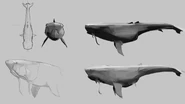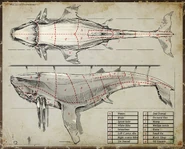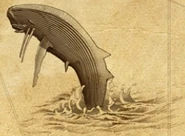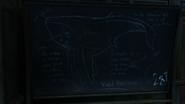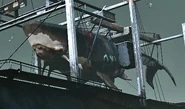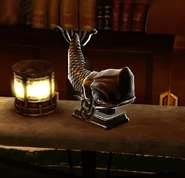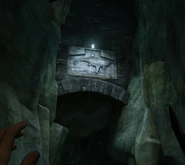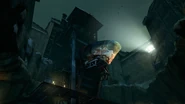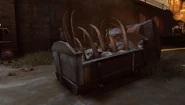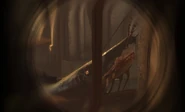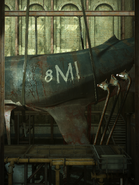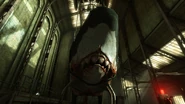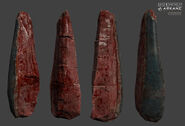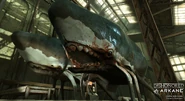- "... Arguments on the 'gentle nature' of the brutes ... [are] refuted by seamen who return to shore, wide-eyed with tales of the whales' savagery."
- —The Leviathans' Sorrow
Whales are enormous waterbound creatures in Dishonored that are hunted for their blubber, meat, bones, and most importantly, their oil.
Characteristics
Described as "creatures of beauty and sadness," whales are magical animals, associated with natural wonder, spirituality, and aesthetics.[1]They have many flippers running down their sides, large, sharp teeth, and barbels hang from their maws. Whaling trawlers hunt them in great numbers for their oil, which is the main source of energy in Gristol, and their bones are also prized for the creation of runes and bone charms.
While whales are seen as dangerous and violent animals by most, there are a few people who perceive them as intelligent creatures, such as Pacotti and natural philosopher Douglas Church.
The Knife of Dunwall
The Knife Of Dunwall DLC features a whale slaughterhouse with a live whale attached to a device to keep it alive for the longest possible time, so as to maximize the final output of whale oil. Daud can use one of Anton Sokolov's devices to end the whale's suffering.
In order to follow Granny's Recipe, which can be found in the first section of the mission A Captain of Industry, Daud must remove the eye of the whale after triggering the electroshock.
Trivia
- Piero Joplin claims to have read about "land-going whales deep in the Pandyssian interior." Whether these creatures are true whales that have evolved to travel on land or different animals that have been misidentified is unknown.
- The whales of Dishonored shares several characteristics with the Livyatan melvillei, an extict species of ancient sperm whale, with the most obvious similarities being the large crown of the head and sharp rows of teeth. The in-universe whale is also sometimes referred to as a "leviathan", which was the original scientific name of the L. melvillei.
Gallery
References
Characters in The Knife of Dunwall | |
|---|---|
| Protagonist | |
| Assassination Targets | |
| Others |
Abigail Ames • Delilah Copperspoon • Thalia Timsh • The Outsider |
| Minor Characters |
Captain Blossom • Chauncy • Corvo Attano • Emily Kaldwin • General Turnbull • Jack • Jessamine Kaldwin • Melissa • Roland • Simmons |
| Character Classes |
Butchers • City Watch Officers • Hatters • Laborers • Overseers • Soldiers • Watch Lower Guards • Whalers |
| Animals | |




